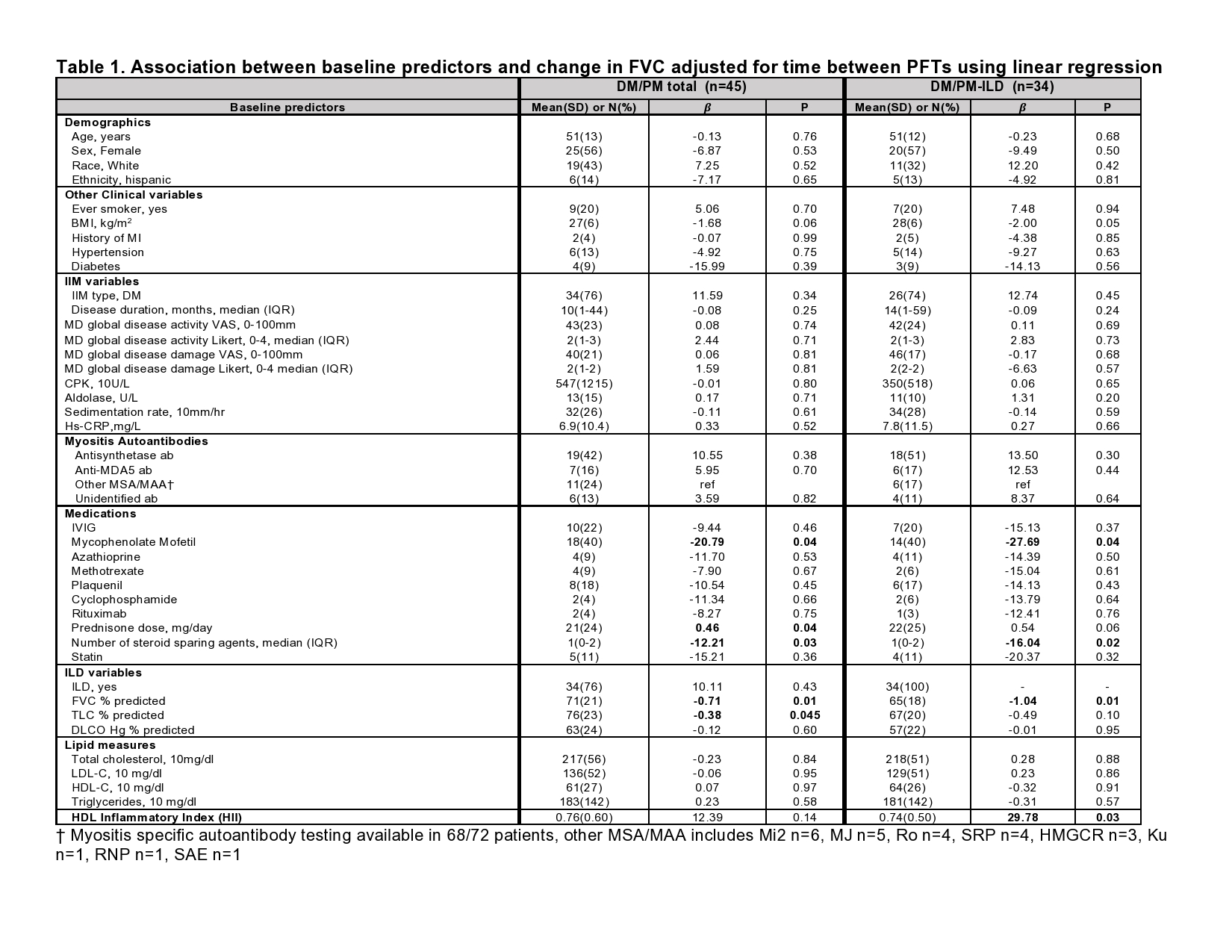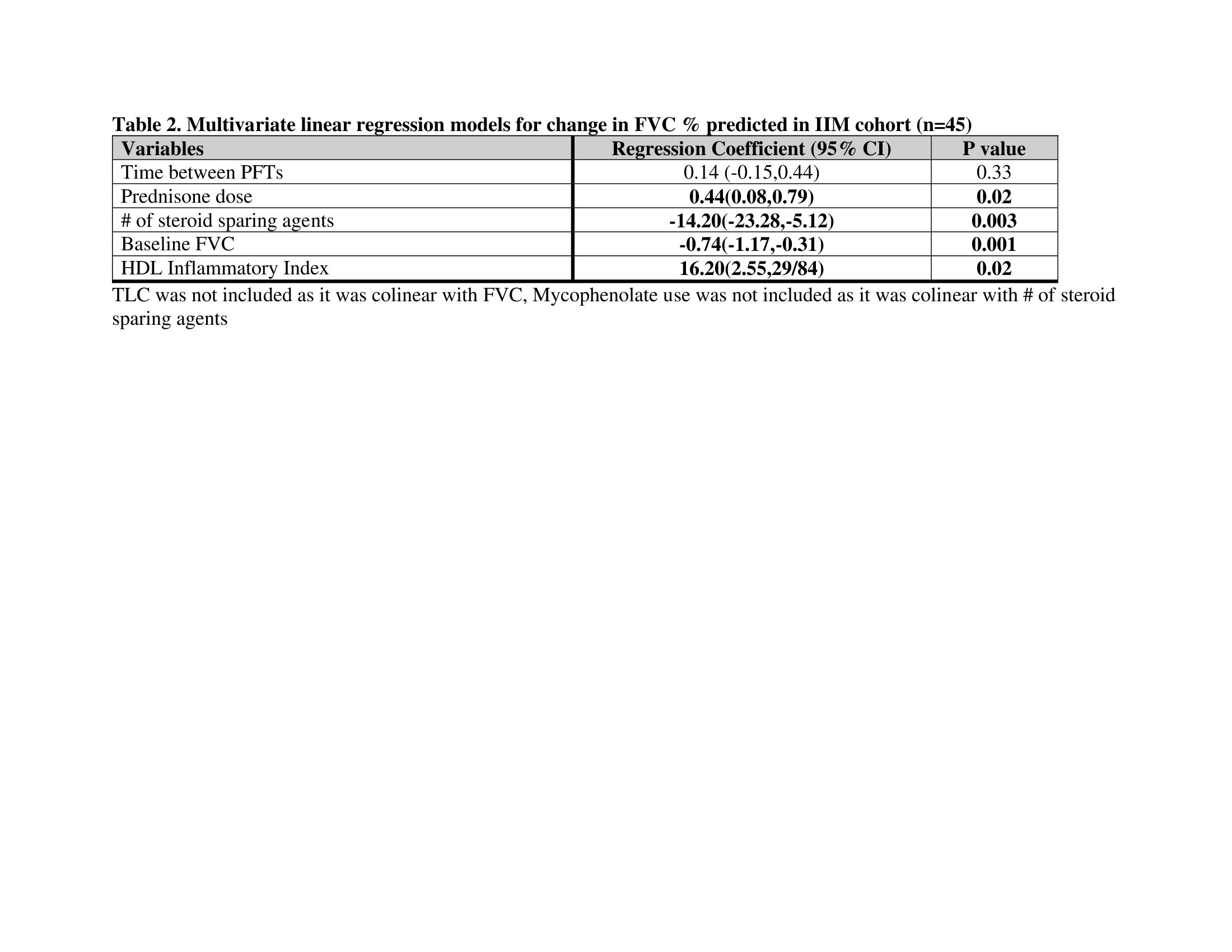Session Information
Session Type: Poster Session C
Session Time: 9:00AM-11:00AM
Background/Purpose: Interstitial lung disease (ILD) is a leading cause of death in patients with dermatomyositis (DM) and polymyositis (PM). We previously reported abnormal anti-oxidant function of HDL in DM/PM patients with ILD, which was associated with higher levels of oxidized fatty acids in HDL and worse lung function. The current project aimed to evaluate the predictive value of baseline HDL antioxidant function for change in lung physiology on longitudinal follow-up in DM/PM patients.
Methods: To determine the anti-oxidant capacity of HDL, the change in fluorescence intensity as a result of the oxidation of 2′,7′-dichlorodihydrofluorescein diacetate to 2′,7′-dichlorofluorescein in incubations with a standard LDL in the absence or presence of the patient HDL was assessed and the HDL inflammatory index (HII) calculated (Arthritis Rheum 60(10):2870-9,2009). Change in forced vital capacity (Δ FVC) at the follow-up visit was calculated as the difference between most recent and baseline FVC divided by baseline FVC. Linear regression models of baseline DM/PM clinical characteristics with ΔFVC as the outcomewere constructed in the total DM/PM group and in patients only with DM/PM-ILD; all models were adjusted for time between baseline and follow-up FVC assessment. Multivariate linear regression analysis examining an association of HII with ΔFVC included other clinical variables that were significantly associated with ΔFVC in univariate analysis.
Results: A total of 45 DM/PM patients with baseline HII assessments and follow-up FVC measurements were included in the study (Table 1). Mean (SD) follow up time between PFTs was 37(31) months. In univariate analysis, a higher baseline HII consistent with worse antioxidant function of HDL was associated with improvement in FVC over the follow-up period. In addition, baseline higher daily prednisone dose, fewer steroid sparing agents, the absence of mycophenolate use, and lower FVC and TLC were associated with greater improvement in FVC (Table 1). Higher baseline HII remained significantly associated with greater ΔFVC over time after multivariate adjustment.
Conclusion: Abnormal antioxidant function of HDL is associated with changes in lung physiology over time. We hypothesize that a higher baseline HII may identify patients with active, reversible lung disease that may be more likely to improve with treatment over time. Further studies are needed to determine the consequences of abnormal antioxidant function of HDL to the progression of DM/PM associated lung disease.
To cite this abstract in AMA style:
Bae S, Wang J, Shahbazian A, Charles-Schoeman C. Abnormal HDL Antioxidant Function Is Associated with Longitudinal Change in Lung Physiology in Dermatomyositis/Polymyositis Associated Lung Disease [abstract]. Arthritis Rheumatol. 2020; 72 (suppl 10). https://acrabstracts.org/abstract/abnormal-hdl-antioxidant-function-is-associated-with-longitudinal-change-in-lung-physiology-in-dermatomyositis-polymyositis-associated-lung-disease/. Accessed .« Back to ACR Convergence 2020
ACR Meeting Abstracts - https://acrabstracts.org/abstract/abnormal-hdl-antioxidant-function-is-associated-with-longitudinal-change-in-lung-physiology-in-dermatomyositis-polymyositis-associated-lung-disease/


